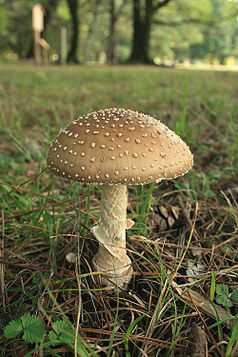Epsilon-Amanitin
| ε-Amanitin | |
|---|---|
 | |
| Other names Amanine | |
| Identifiers | |
| CAS number | 21705-02-2 |
| PubChem | 30508 |
| ChemSpider | 26234941 |
| Jmol-3D images | {{#if:O=C(NCC(N[C@@](C(NCC(N[C@@H](C3)C(N[C@@H](CC(O)=O)C(N5[C@H]4C[C@@H](O)C5)=O)=O)=O)=O)([H])[C@@H](C)CC)=O)[C@H](CC1=C(S3=O)NC2=C1C=CC(O)=C2)NC([C@@]([C@@H](C)[C@@H](O)C)([H])N[C@@]4=O)=O|Image 1 |
| |
| |
| Properties | |
| Molecular formula | C39H53N9O14S |
| Molar mass | 903.96 g/mol |
| Appearance | Colorless, crystalline solid |
| Solubility in water | Soluble |
| Solubility in ethanol and methanol | Soluble |
| Except where noted otherwise, data are given for materials in their standard state (at 25 °C (77 °F), 100 kPa) | |
| Infobox references | |
epsilon-Amanitin or ε-amanitin is a Cyclic peptide. It is an amatoxin, all of which are found in several members of the Amanita genus of mushrooms. The oral LD50 of ε-amanitin is approximately 0.1 mg/kg.
Toxicology
Like other amatoxins, ε-amanitin an inhibitor of RNA polymerase II. Upon ingestion, it binds to the RNA polymerase II enzyme which completely prevents mRNA synthesis, effectively causing cytolysis of hepatocytes (liver cells) and kidney cells.[1]
See also
References
- ↑ M. Cochet-Meillhac and Chambon P. (1974). "Animal DNA-dependent RNA polymerases. 11. Mechanism of the inhibition of RNA polymerases B by amatoxins". Biochim Biophys Acta 353 (2): 160–184. doi:10.1016/0005-2787(74)90182-8. PMID 4601749.
External links
- Amatoxins REVISED
- Poisonous Mushrooms (German)
| |||||||||||||||||||||||||||||||||||||||||||||||||
| ||||||||||||||||||||||||||||||||||||||||||||||||||||||||||||||||||||||||||||
